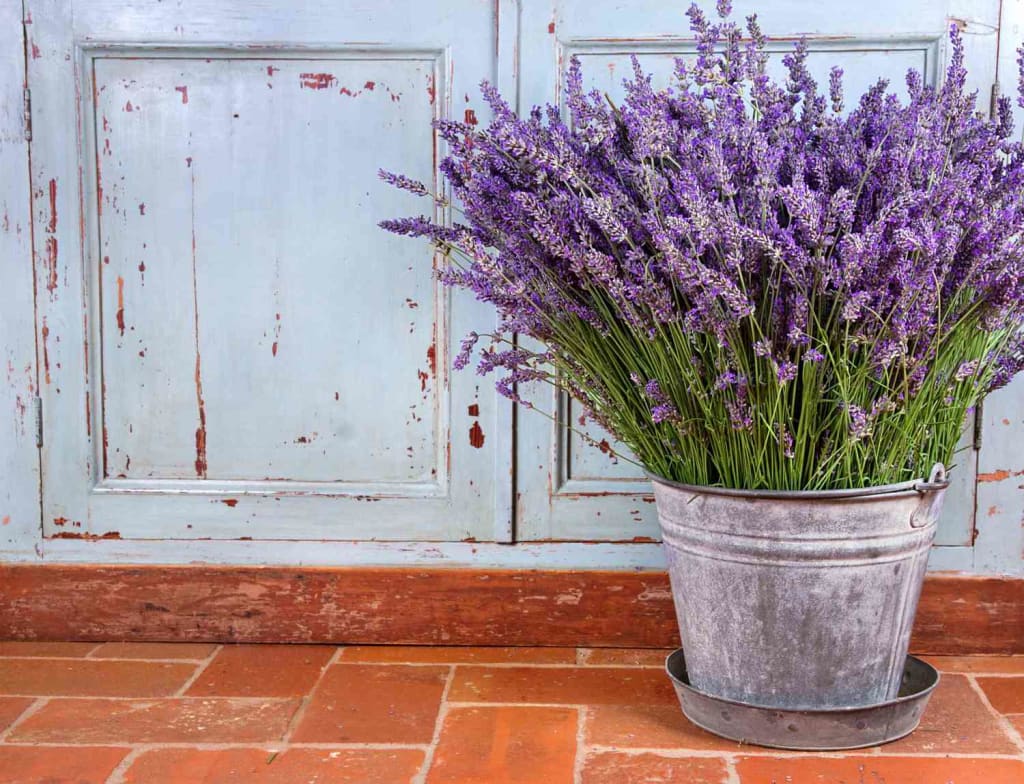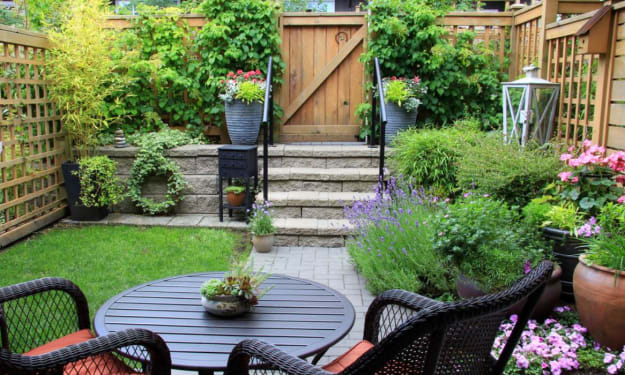Potted lavender. How to care for a lavender plant?
What are the characteristics of lavender?

Lavender is an exceptionally beautiful plant with many useful qualities. It can be found in many gardens, amazing with its intense color. Lavender has been valued for many years not only for its beautiful color but also for its strong fragrance. It is also easy to grow and not too troublesome. It turns out that you don't have to have a garden to benefit from this plant. If your space is limited, potted lavender is a perfect solution for you. Do you wonder how to take care of it? We know tricks that will make your lavender a really impressive decoration.
What are the characteristics of lavender?
Lavender is a shrub belonging to the lamiaceae, mint family. It is both a decorative and cultivated plant. Lavender usually reaches half a meter, although there are also taller species. Its characteristic feature is the purple, sometimes blue, flowers that grow upright. They give off a slightly camphorated smell. Lavender is valued for its health benefits. The plant is also used in the perfume industry and for culinary purposes.
The valuable parts are the flowers, usually in a dried form. They are also used for the production of essential oils. It has antiseptic purposes.
Lavender has many other purposes that can be appreciated by all women. In the age of natural cosmetics, lavender is becoming more and more appreciated. It hinders the production of sebum in the skin, so it is perfect for oily and combination skin. It is a great help for acne and pimples, as well as skin discoloration.
If you grow lavender in your garden or as a pot plant on the balcony, you can make your own skin care products.
Lavender has a calming effect on the human nervous system. It is also a good stimulant in case of mental fatigue. Drinking as an herbal tea or added to various dishes, lavender stimulates the digestive system and relaxes the muscles. It also relieves pain.
Considering those characteristics, as well as its beautiful shape, it is worth having lavender in your home. You can grow it in your garden, on a balcony or in the kitchen. Lavender in a pot is not too difficult to grow. You just need to remember a few principles to make your plant healthy and attractive.
Lavender in a pot: what should you know about it?
Potted lavender is perfect for anyone who wants to enjoy this plant on their balcony. You can decide to buy a seedling or sow it yourself. The last method requires much more attention, since the seeds must undergo stratification. It is nothing more than cooling the seeds, which should last approximately three weeks.
The best time for lavender seed stratification is February. How to do it? Prepare a small container and fill it with soil. Plant the seeds and place the container in a room where the temperature stays around 32 F (0 C), such as a basement. You can also chill the lavender seeds in the refrigerator; it is definitely a more convenient method. This way you don't have to worry about ground frost.
Growing a lavender plant at home is not a very difficult task. The plant does not need much attention. Well planted, lavender will serve as a decoration for many years. There are many species of lavender, and most of them can be planted in pots. Plants that are not frost resistant are perfect for this purpose.
Growing lavender at home – species
One of the most common types of lavender is English lavender. It is very resistant to low temperatures and frost. Most lavender plants are suitable for growing in a pot, especially those that won't survive cold temperatures. When choosing a plant, remember that various types reach different heights. There are around 30 different species of lavender.
The most popular types are:
English Lavender – Also known as true lavender. It is frost resistant, so it can survive in difficult conditions in cold climates. It can reach up to 1 meter. English lavender flowers come in various colors, from white to deep purple.
French lavender: the species is less resistant to low temperatures. It can survive down to -7 degrees Celsius, so in cold regions it is an annual plant. French lavender flowers are more impressive than English lavender. The flower petals protrude, resembling the wings of a butterfly. Due to the large amount of oils, the plant is not used for cooking.
Spanish Lavender – Also known as a different type of French lavender. The flowers are white, purple or blue. The plant is not edible. It is vulnerable to low temperatures, so in cold regions it is grown in pots.
Broadleaf Lavender – Similar to English lavender, this species can survive very low temperatures. It has a stronger aroma, its flowers are used in the production of a strong essential oil.
Lavender x intermedia – is a hybrid between English lavender and broadleaf lavender. Its leaves have a beautiful silvery-green color. The flowers are purple. The plant can grow up to 60 cm.
Lavender blooms between June and September. Flowering times can vary, depending on several factors. Most species have evergreen leaves.
How to plant a lavender in a pot?
Regardless of the type of plant, all species have similar requirements. Potted lavender needs more attention than lavender grown directly in the ground, as it has less room to grow.
The lavender plant should grow in a large container. It is advisable to use ceramic pots, since they allow the water to evaporate naturally. With plastic containers there is a risk of water remaining inside. Be sure to place a drainage layer at the bottom of the pot, along with the drainage holes. Lavender does not tolerate excessive moisture. The best soil for a lavender plant is dry, light, rich in calcium, and alkaline or neutral. You can use universal potting soil mixed with sand in 1:1 ratios or buy a special lavender soil from a florist. After planting a new plant, cover its roots with an extra layer of soil.
Lavender in a pot grows best in sunny locations - choose windows facing south and west. The plant likes the wind, so don't worry if there are drafts in the place. In summer you can place the pot on a balcony or patio.
You can also try seeding the plant. Seeds need to be stratified first (about two months). To do this, you can mix them with sand, put them in the fridge and plant them in spring. Young plants flower after one year. Their colors may differ from the mother plant.
Lavender Plant Care Guide
Lavender is a plant that does not like to be in the shade. Excessive moisture is also not good for it. Water it 1-2 times a week. Be sure not to overwater the lavender, or it may stop growing. It's best to let the soil dry out a bit, but don't let it dry out completely. Fertilize the soil every two weeks from April to July. A liquid fertilizer is best for this purpose.
Lavender needs pruning. Do it about twice a year to keep the plant looking good. Such a procedure also prolongs the flowering time. While you can cut up to half the length, it's best to cut 2/3 of a branch off.
Lavender also needs to hibernate. For this purpose, move the plant to a room with a lower temperature. Do not forget to water it, otherwise the plant will die. Lavender is not very popular with vermin: its strong smell works as a natural repellent. The plant can be transplanted to a new place after it stops flowering.
The only disease that can attack a lavender plant is botrytis (a type of fungus). It will happen if the plant is watered excessively. To avoid this, don't let the roots get too soaked. Pour the water from the saucer immediately, so that it is not absorbed back into the soil.
Lavender at home – examples of arrangements
You can plant a lavender singly or in groups, just make sure your container is big enough. The plant looks very nice and is therefore a decoration in itself. You can also combine it with other species of balcony plants. Choose plants of similar requirements.
The species that can grow with lavender in a pot are:
wise,
marigolds,
tick seeds,
roses
Lavender should be combined with flowers of delicate colors that do not dull. A good idea is to make a composition with Herbs de Provence. It's a perfect arrangement for the kitchen - it can serve as both a decoration and an indoor herb garden.
Lavender is best suited to country-style interior designs. Choose interesting containers for it, for example, colored ceramic pots. You can also use metal buckets or even an old watering can.
How to use lavender?
Lavender has many properties. For this reason, the plant is definitely worth having. There are many ways that you can use lavender flowers. See those listed below:
Insect repellent – Insects, for example mosquitoes, hate the strong smell of lavender. You can put dried flowers in small cotton or linen bundles and hang them wherever they are needed, for example in a bedroom. It's also a good remedy for moths - just put one of the packets somewhere in your closet.
Headache Remedy: The scent of lavender is calming and relaxing. You can put some fresh cut lavender flowers in a vase in your bedroom. You can also put a package with dried flowers under the pillow, it will help you fall asleep.
Seasonings – Lavender is sometimes included in a popular seasoning mix: Herbes de Provence. You can use the plant to season many dishes, especially poultry. Be careful though: lavender has a strong scent. If you overuse it, it will kill the flavor of the whole dish. You can also add flowers to desserts and ice creams.
Lavender sugar – it is very easy to prepare. Simply mix some sugar with lavender flowers, fresh or dried, and place in an airtight container for several weeks. After this time, sift the sugar to separate it from the flowers. It is perfect for coffee, tea, cakes and cookies.
Lavender Decorations – Cut and dried lavender sprigs make great decor items. You can use them to decorate candles or just pile them up and put them in a vase.
Those are just a few uses for lavender. Obviously there are more ideas, just use some inspiration and your own creativity. Lavender is a remarkable plant, definitely worth having in your garden or at home. There are many species of different appearances to choose from. As part of a balcony decor, the plant needs only a little attention, which isn't much compared to the amount of benefits it provides. Lavender in a pot is a great idea for decorating any interior design.
How to grow lavender?
You can grow lavender in your garden or, if you don't have one, in a container. Lavender is not difficult to grow, although the potted plant requires more attention.
How to dry lavender?
Cut several branches and tie them into a bunch with a piece of twig. Hang it in a dry and warm place.
When does lavender bloom?
Lavender blooms between June and the end of September. The time may vary, depending on weather conditions.
When to plant lavender?
You can plant lavender throughout the season, from the beginning of April to the end of September. You can transplant lavender after the flowers stop blooming, in early spring or early fall.





Comments
There are no comments for this story
Be the first to respond and start the conversation.